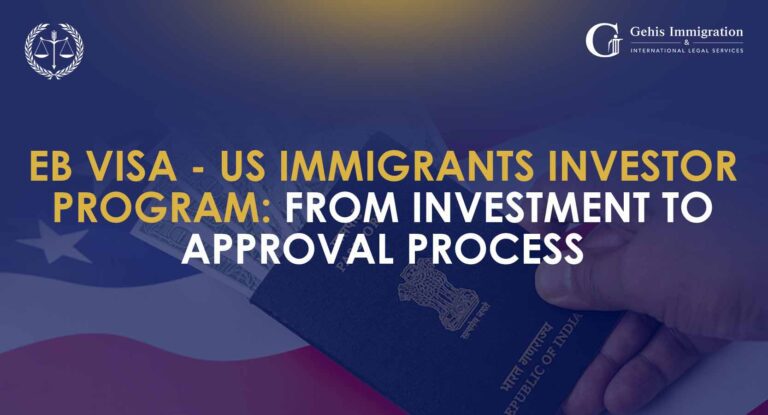The USCIS manages the EB-5 program. Under this scheme, investors (and their spouses and unmarried children under the age of 21) are entitled to apply for a green card (permanent residence) if:
- They make the necessary investments in commercial business in the United States
- Planning to create or maintain ten permanent full-time jobs for skilled workers in the United States.
This program is called EB-5 after the fifth work-based preferential visa that participants receive. Congress created the EB-5 program in 1990 to stimulate the US economy by creating jobs and investing capital in foreign investors. In 1992, the Immigrant Investor Program was introduced by Congress, which provides EB-5 visas to participants who invest in commercial enterprises affiliated with approved regional centers in USCIS based on proposals to promote economic growth.
There are four steps in the EB-5 petition process that an immigrant investor must be willing to complete in order to become a permanent resident of the United States, along with his or her husband/wife and unmarried kids less than 21 years of age.
EB-5 Visa – How to Select a Qualified EB-5 Project?
Applicants must first find an EB-5 and a suitable project that they believe meets the program’s requirements, especially if they are interested in rapid processing offered through rapid approval and premium processing.
When choosing a suitable EB-5 investment, consider the following two desired results – Green Card and Return on Capital. The first is related to the possibility of immigration benefits, and the second is to the possibility of recovering capital on time.
EB-5 Visa – How much should you invest in the EB-5 project?
EB-5 visa applicants must invest $ 1,050,000 or $ 800,000 if job creation occurs in targeted employment (TEA) in an American company.
TEA teaching applies to projects in rural or high-lying areas without employment.
Requirements for performing the work
The work is a critical prerequisite for the success of the EB-5. The investment must lead to the creation of 10 full-time jobs in the US to qualify for EB-5.
The EB-5 program allows the inclusion of indirect and causal jobs for job creation. The EB-5 permanent direct program only counts direct contracts directly for a company that has received a capital investment. The fastest processing of projects for national interest EB-5 investments, which are considered to be in the national interest, will soon receive US approval.
Citizenship and immigration services
The result will be processed in just two to six months. This is the fastest possible processing of the EB-5. Dedicated processing of visas and premiums for rural projects. Rural investment projects have allocated 20% of the total number of EB-5 visas and receive a processing premium.
Lawyers anticipate that this processing will take a year or less. It allows investors to obtain a valid visa immediately. While a standard EB-5 investment may result in 10-14 years of waiting for a Chinese investor to obtain a green card with a national investment, a Chinese investor can live in the US for half a year.
The US Citizenship and Immigration Service (USCIS) will give prior approval to petitioners for the same project. Therefore, if the project has received investor approval or the New Commercial Enterprise (NCE) asks for sample approval, investors may have more confidence that the immigration service can accept their petition. However, it does not guarantee approval if there have been substantial changes since the project was approved.
Keep in mind that the consent of the investor as a model consent does not mean that the project will fully perform the rough work. The financial return on your investment in EB-5EB -5 investors want to be sure that their capital is fully paid up – if not at all – to ensure an attractive return. The main factors that help determine the strength of investment include capital stock and developer equity.
In fact, EB-5 money is fully secured by the project’s equity. Another aspect to look for is an exit strategy when your borrowed capital returns to you as an investor. You want your exit strategy to match your I-829 filing date, a time when your EB-5 investment capital may no longer be at risk.
Historically, the EB-5 project, which is likely to provide the benefits of immigration, has usually not been a project that provides a high return. A higher rate of return often indicates an increased risk. But as the market grows, legitimate investments in EB-5 offer better returns.
What sector should you be in with EB-5 investment?
In previous years, real estate projects favored EB-5 investments because the work is modeled by the economist to carry it out as long as the entire business plan budget is exhausted. Due to the fact that real estate projects are rarely under budget, this simplified work is very important and reduces the risk of creating work. Large real estate projects on the site are therefore considered the most attractive because they are considered safer for work.
However, since the implementation of the EB-5 Reform and Integrity Act of 2022 and the new rules of the EB-5 Targeted Employment Areas (TEAs) program, many of these large urban projects no longer qualify for low levels of investment. Therefore, real estate may not be as attractive for the EB-5 option project as it used to be.
Many investors are motivated to pursue a TEA project for a shorter investment amount, visa waivers, and premium processing for rural investments. They need to understand that TEA investment projects, especially in rural areas, can cover a wide range of industries. Many new commercial businesses no longer rely on placement, making it easier for them to qualify for TEA training. Current EB-5 projects can be in a variety of industries, including manufacturing, healthcare, call centers, technology companies, and more.
If an investor does not mind investing $ 1,050,000 million in a non-TEA project, it should be open to different types of projects and locations.
How do you make an EB-5 investment?
In order for investors to make an investment, they will sign a subscription agreement and an application to join a company or a limited liability company. The manager, as the general partner, then accepts the investor, who transfers his investment funds to a restricted account managed by a designated escrow agent.






